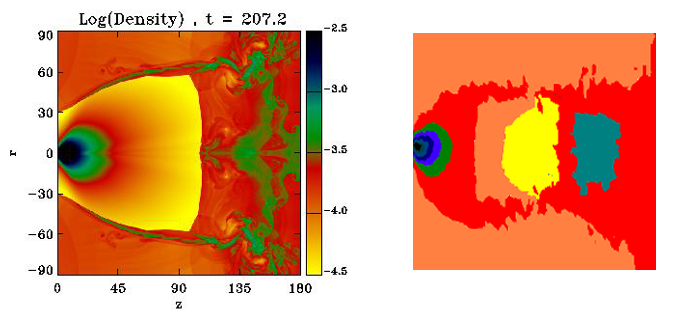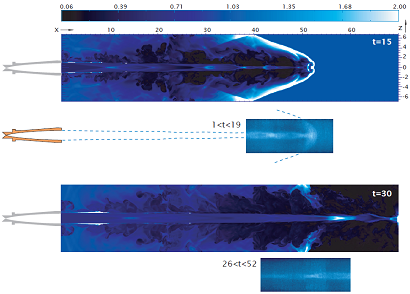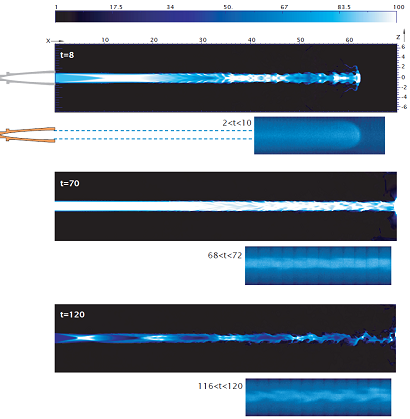Hydrodynamics of Hypersonic Jets
- Details
- Last Updated on Friday, 27 April 2012 10:59
Longterm dynamics of rarefied jets.
- Visualization of density and concentration distributions inside and outside the barrel shock in underexpanded hypersonic jets. We show that the jet growth clearly depends on the sign of the density gradient between the gas in the jet and that in the ambient surroundings (Physical review E 2010, Experiments in Fluids 2008, Astrophysics and Space Science 293, 2004).


Figure 1. A new fluorescent image analysis ù procedure to determine the distribution of species concentration and density in a gas flow is proposed (Exp. Fluids, 2008). The fluorescent emission is due to the excitation of atoms/molecules of a gas that is intercepted by an electron blade.
|
|
|
Figure 2. Extraction of the density profiles from the recorded images by means of a new fluorescent image analysis procedure (Exp. Fluids, 2008). Left: air jet. Right: He/Ar jet.
Astrophysical applications. (References: New Journal of Physics 2011 and also NJP Highlights 2011; Astrophysics and Space Science 2011).
<<<<<This experiment reproduces a few hydrodynamical properties of high Reynolds number hypersonic jets which exist in the Universe. Three-dimensional DNS of astrophysical flows undergoing shear-layer instabilities can, nowadays and in a foreseeable future, capture just the behavior that occurs at the largest scales, but not the development of turbulent motions, which are very likely induced by the instabilities. Recently, we proposed a general method that allows the detection of small turbulence scales. In order to locate the small scales, we propose the introduction of a criterion based on the local structure of the vorticity field, in particular, on its twisting and stretching intensity. In such a way, it would be possible to selectively introduce a compressible sub-grid scale model (for example, the Smagorinsky Model evaluated by means of Favre-averaged quantities, Computer Physiscs Communications. 176, 2007).
The study and implementation of the present technique are carried out in an apparatus designed for the study of hypersonic jets (Politecnico di Milano, DIAS). A set of De Laval nozzles built at CERN a available to generate jets at a Mach value of 5, 10, 15 and 20.
|
|
Figure 3. Hypersonic light jet, helium in xenon, M= 16.1, 0<t<66 t_jet . Image reworked by means of multicorrelation techniques.
|
<<<<<<< |
Figure 4. Hypersonic heavy jet, Xe in Ar, 0<t<20 t_jet and 60<t<70 t_jet . Images reworked by means of multicorrelation techniques.
 |
|
Figure 5. Comparison between numerical simulations and laboratory experiments (higher resolution images and movies are in the gallery).
|
|
Figure 6. e in the gallery).
-----------------------------------------------------------------------------------------------------------------------------------------------------------------------------------------------------------------------------------------------------------------------------
More images about hypersonic jets are in the gallery.










